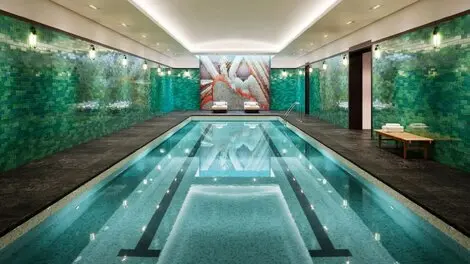
Owning an indoor pool is an appealing luxury that provides the benefit of year-round swimming and relaxation. However, this luxury also brings along certain challenges, one of the most significant being the management of indoor pool humidity.
Indoor swimming pools naturally generate substantial humidity due to evaporation, which, if left unchecked, can escalate into excess humidity. This excessive humidity can pave the way for a host of issues, ranging from discomfort for swimming pool users to potential damage to the surrounding structures and even health hazards associated with mould growth.
Understanding how to control humidity and mould for an indoor pool becomes paramount in this context. This not only ensures a comfortable and healthy swimming environment but also extends the lifespan of your pool and the surrounding infrastructure.
Today, we will look into the intricacies of controlling moisture and maintaining proper humidity levels in your indoor pool area. With the right measures in place, you can make the most of your indoor pools while ensuring a safe and enjoyable environment for all.
Understanding Humidity in Indoor Pool Areas
Indoor pools are a significant source of humidity. When the pool water heats up, it evaporates, increasing the water vapour in the air and causing high indoor pool humidity. This humid air can cause discomfort to pool users and also lead to more serious issues, such as damage to building materials and increased energy costs.

The water temperature in your pool can greatly influence the humidity levels. Higher pool water temperature can lead to more evaporation, thus increasing the humidity in indoor pools. So, controlling pool water temperature is essential in maintaining proper humidity levels.
The Dangers of Mould Growth
In an enclosed environment like an indoor pool room, excessive humidity can create a breeding ground for mould. If left unchecked, mould can spread rapidly on room surfaces, including exterior walls and windows. Mould exposure can cause:
- Health Risks: Mould can cause allergic reactions and respiratory issues when inhaled, particularly in individuals with pre-existing conditions.
- Structural Damage: Over time, mould can weaken and damage building materials like wood and drywall, leading to expensive repairs.
- Aesthetic Impact: Mould negatively affects your pool area’s visual appeal and smell, making it less inviting for users.

- Increased Maintenance Costs: Dealing with mould can be challenging and costly, raising regular cleaning and maintenance expenses.
- Reduced Air Quality: The presence of mould can lower indoor air quality, leading to a musty, uncomfortable atmosphere.
High indoor pool humidity affects not only the pool users but also the structural integrity of the surrounding structures. Uncontrolled humidity can lead to condensation on cold surfaces, seeping into the building materials and causing them to deteriorate over time.
How To Maintain Proper Humidity Levels
Utilising Pool Dehumidifiers
Controlling moisture in indoor swimming pools is crucial for ensuring good air quality and preventing mould growth. An effective approach to managing humidity is deploying an indoor pool dehumidifier. These devices work by extracting water vapour from the indoor air, assisting in maintaining a comfortable relative humidity level.
Circulating Cooled Air
An alternative method involves the circulation of cooled air using air ducts. This technique can lower the dew point and help avoid condensation. However, it’s crucial to remember that cold air can also cause condensation on cold surfaces, making it imperative to balance the air volume and temperature.

Harnessing Heat Recovery
Heat recovery represents another effective tactic for managing humidity. A heat recovery pool dehumidifier operates by harnessing the heat from the humid air to warm up the pool water, thereby reducing the humidity load. This process not only helps control humidity but also assists in maintaining the pool water temperature.
Ensuring Proper Ventilation
Finally, proper ventilation is essential. The introduction of outdoor air can assist in diluting the humid air while also maintaining a healthy breathing zone for pool users. However, this method should be cautiously employed as it could lead to heat loss and increased energy costs.
Preventing and Controlling Mould Growth
Keeping the pool area clean and well-maintained is the first line of defence against mould growth. Regular cleaning routines, especially targeting surfaces that are susceptible to mould, can go a long way in preventing its occurrence. Using anti-mould products on these surfaces, particularly in areas where condensation frequently forms, can offer added protection.
It’s also crucial to maintain your pool dehumidification equipment regularly. For instance, you should keep an eye on your pool dehumidifier to avoid issues like an overflowing condensate drain pan or drain line blockage. Such issues, if left unchecked, can create an environment conducive to mould growth by increasing indoor humidity levels.

Professional mould remediation may be necessary if mould has already established a foothold. Experts can safely and thoroughly remove the mould, ensuring no spores remain that could trigger a future outbreak.
However, simply removing mould is not sufficient. It’s equally important to address the root cause — high humidity. Regular annual check-ups of your dehumidification system can ensure it’s functioning efficiently, helping keep the indoor pool humidity in check. This, in turn, aids in preventing the recurrence of mould.
Investing in a high-quality humidity monitoring system can also provide real-time data about indoor humidity levels. This allows for timely interventions and adjustments to your humidity control strategies, further aiding in mould prevention and the overall maintenance of a healthy and comfortable pool environment.
Keep Your Indoor Pools Fresh And Clean
Having an indoor pool is wonderful, but it comes with the responsibility of maintaining a healthy and comfortable environment. Understanding and controlling high humidity is essential, not only for the comfort of the pool users but also for the pool’s longevity and surrounding structures.
Remember to monitor your humidity levels regularly and take proactive steps to maintain proper humidity. If you need help controlling humidity and mould in your indoor pool,contact our indoor pool professionals at The Pool Co in Sydney. We can provide guidance on pool chemistry, humidity control, and mould prevention, ensuring that your indoor pool remains a safe and enjoyable space.
Take care of your indoor pool, providing you with years of enjoyment. Happy swimming!



